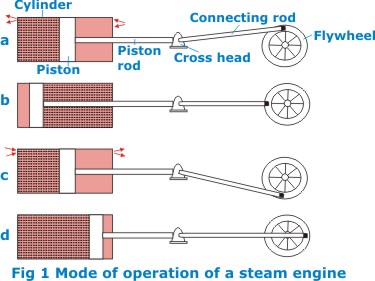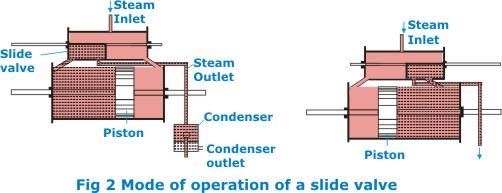Steam Engine |
|
|
A steam engine utilizes the energy contained in steam under
high pressure. The energy that is released when steam expands
is made to produce rotary motion which can be used for the
driving of machinery.
|
|
|
Steam engines were first invented by Thomas Newcomen in 1705,
and James made big improvements to steam engines in 1769.
The Newcomen steam engine used the force of atmospheric pressure
to do the work. In 1712, Thomas Newcomen together with John
Calley built their first engine on top of a water filled mine
shaft and used it to pump water out of the mine.
|
|
 |
|
|
The steam from the boiler is admitted into the cylinder in
which there is a piston and in which the steam expands, causing
the piston to move (Fig.1a). When the piston has traveled
to the end of the cylinder and thus completed it does stoke
(Fig.1b), the now expanded stream is allowed to escape from
the cylinder.
|
|
| At
the same time the steam is changed over, live steam under
pressure being admitted to the other side of the piston, causing
the latter to travel back, past its starting point (Fig 1c),
until it has reached the other end of its stroke (Fig 1d).
A steam engine of this kind is called double-acting because
the force of the steam is applied alternatively on two sides
of the piston. While the piston is being forced in one direction
by the expanding stream, the spent stream is pushed out of
the cylinder on the other side of the piston.
|
|
| The
change over of the steam supply to ensure the admission of
live steam to appropriate side of the piston and the discharge
of the spent steam on the other side, is effected automatically
by a control device called a slide valve. Some steam engines,
valves are similar in principle to those used in internal
combustion engines. The commonest type is the flat slide valve,
also called a D-slide valve (Fig.2).
|
|
 |
|
| It
alternatively covers the steam inlet port and exhaust port.
During the piston movement the slide valve opens the exhaust
port for the escape of the spent stream behind the piston
(Figs. 2a and 2b). The slide valve must therefore always be
in such a position that it connects the working side of the
piston to the live steam supply, and opens the exhaust port
on the other side to enable the stream to escape into the
exhaust channel. |
|
|
| |
|
The valve performs this operation by moving to-and-fro at
the same rate as the piston. It is controlled through a linkage
system from the crankshaft such that the valve moves in the
opposite direction to the piston. The spent steam that emerges
from the cylinder is passed to a condenser where it is cooled
and thereby precipitated as water. In some cases it is, instead,
discharged direct into the atmosphere. |
|
|
The term compound steam engine refers to an engine in which
the steam is expanded in several cylinders usually three,
in successive stages. As a rule, all three pistons have the
same length of stroke, since they drive the same crankshaft.
However, as the volume of the steam increases as the result
of expansion, i.e., when its pressure is reduced, the second
or medium-pressure stage has a larger piston diameter than
the first stage or the high-pressure stage. The third or low
pressure stage has a piston of still larger diameter than
the second stage. |
|
|
The transmission of power and motion from the piston to the
crankshaft is effected through a crosshead i.e. a reciprocating
block sliding between guides which forms the junction piece
between the piston-rod and the connecting-rod. One end of
the latter is pivotally connected to the crosshead and other
end is connected to the circumference of a wheel or to a crank
of the crankshaft. When the piston, piston rod and crosshead
move to and fro, the crosshead transmits this movement to
the crankshaft or wheel and thus produces rotation. One end
of the crankshaft is provided with a fly wheel to ensure smooth
running, free from jerkiness due to the reciprocating motion
of the piston. |
|
|
Nowadays steam engines are used only in cases where the slow-running
machinery with varying power requirements has to be driven,
e.g. for winding gear in coal mines, ships propulsion machinery,
rollers, etc. Even the best steam engines have an efficiency
of only 15-18% in terms of utilization of the energy contained
in the coal. |
|
|
o
DISCLAIMER o
CONTACT US |